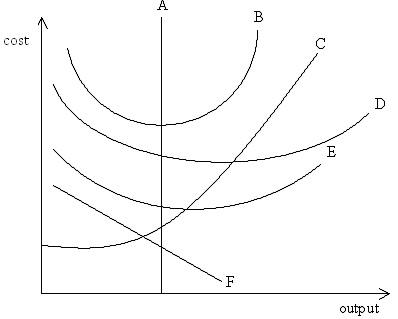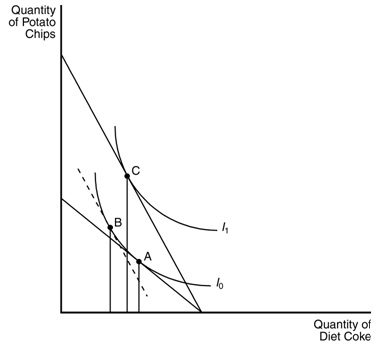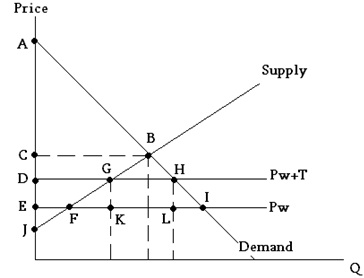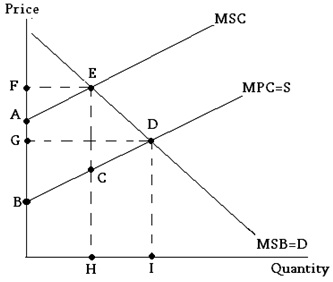Reference no: EM131018673
Midterm Two from the Afternoon
1) If the domestic market price is below the world price, then opening up the economy to trade will:
a. reduce consumer surplus, increase producer surplus.
b. increase consumer surplus, reduce producer surplus.
c. increase both consumer and producer surplus.
d. reduce both consumer and producer surplus.
e. increase consumer surplus, leave producer surplus unchanged.
2) Which of the following must be always true as the quantity of output increases?
a. Marginal cost must rise.
b. Average total cost must rise.
c. Average variable cost must rise.
d. Average fixed cost must fall.
e. Marginal productivity must rise.
3) Average total cost equals average variable cost when:
a. Fixed costs are small and the marginal cost is decreasing.
b. The marginal cost is zero.
c. Marginal cost equals average variable cost.
d. Marginal cost equals average total cost.
e. Fixed costs are zero.
4) Indifference curves graphically represent
a. an income level sufficient to make an individual happy.
b. the constraints faced by individuals.
c. the money an individual could have.
d. the relative price of commodities.
e. an individual's preferences.
5) The largest source of federal tax revenue is:
a. the Corporate income tax.
b. the Personal income tax.
c. the Sales tax.
d. the Property tax.
e. the Social Security tax.
The next FOUR questions are based on the following:
Stan, Kyle and Bob all enjoy watching fireworks (here, fireworks are non-excludable and non-rival). Suppose a fireworks display currently has 12 rockets, and can be expanded by another rocket for the cost of $10. Stan would be willing to pay $6 to expand it, Kyle would be willing to pay $3, while Bob would only pay $2. The provider of rockets, who does not know their willingness to pay, now asks each of them to pay the amount they are willing to pay to decide whether or not to provide the additional rocket.
6) What is the marginal benefit of providing one additional rocket?
a. $2 b. $3 c. $6 d. $10 e. $11
7) Given the information, which of the following is correct?
a. It is efficient to add another rocket since the sum of the individuals' willingness to pay for exceeds the marginal cost of providing the additional rocket.
b. Since the cost of adding another rocket exceeds everyone's willingness to pay, it's better not to add the additional unit.
c. If for some reason Kyle can't come to watch the show, it is still efficient to provide another rocket.
d. We will need additional information to decide whether it's efficient to provide another rocket for the show.
e. None of the above is correct.
8) Which of the following is NOT true?
a. The provider will finally decide not to provide the additional rocket.
b. Bob, who has the smallest valuation, will have an incentive to exaggerate his valuation.
c. Stan, Kyle and Bob will tell the truth when they are asked their willingness to pay.
d. We have a free-rider problem here.
e. The main problem here is that it's difficult to exclude people from watching the new show once the additional rocket is provided.
9) Now suppose Bob does not value the additional rocket at all (everything else is the same). Then what is the efficient amount of additional rockets that should be provided?
a. 0
b. 1
c. 2
d. 3
e. 4
10) An example of a good that is both rival and excludable is
a. the defense services provided by a new stealth bomber.
b. a personal computer.
c. a beautiful sunset.
d an uncrowded theme park such as Walt Disney World.
e. fish in the ocean.
For the next THREE questions consider the following: the market supply curve is Q=P-2. The marginal private benefit curve is P=10-Q, while the marginal social benefit is P=14-Q.
11) The market equilibrium quantity is ______, and the socially efficient quantity is _______.
a. 4, 6
b. 6, 4
c. 6, 8
d. 8, 6
e. 10, 14
12) Which of the following government policies will induce the socially efficient outcome? The government enacts a
a. tax of $4/unit on suppliers.
b. subsidy of $4/unit on suppliers.
c. tax of $4/unit on consumers.
d. subsidy of $4/unit on consumers.
e. price ceiling of $6/unit.
13) For some reason the marginal social benefit curve has changed. If the marginal social benefit curve is P=8-Q, then the socially efficient quantity is ____, and in this case we have a ____________.
a. 5, positive externality.
b. 3, positive externality.
c. 5, negative externality.
d. 3, negative externality.
e. 5, public good.
Consider the following table for the next TWO problems:
|
Levee height (feet)
|
Total benefit (millions of dollars)
|
Total cost
(millions of dollars)
|
|
1
|
100
|
0
|
|
2
|
180
|
10
|
|
3
|
240
|
30
|
|
4
|
280
|
70
|
|
5
|
300
|
130
|
14) Valley City is considering building a levee to protect its residents from flooding. The total costs and benefits are in the table above. The marginal cost of the third foot of the levee is equal to
a. $20 million.
b. $30 million.
c. $40 million.
d. $240 million.
e. $210 million.
15) Based on the data in the table above, the efficient levee height is:
a. 1 foot.
b. 2 feet.
c. 3 feet.
d. 4 feet.
e. 5 feet.
Consider the following table for the next THREE problems:
|
Taxes in Taxland
|
|
Income range (dollars)
|
Marginal tax rate for the range of income (percent)
|
|
0 to 10,000
|
20
|
|
10,001 to 20,000
|
40
|
|
Over 20,000
|
60
|
16) The income tax system in Taxland is:
a. regressive.
b. progressive.
c. proportional.
d. retroactive.
e. flat
17) Duval makes $40,000 and lives in Taxland, which has no personal exemptions and no deductions. Based on the information in the above table, his total taxes will be
a. $12,000.
b. $18,000.
c. $24,000.
d. $34,000.
e. $35,000.
18) The average and marginal tax rate faced by Duval, respectively, are:
a. 40% and 60%.
b. 45% and 60%.
c. 45% and 40%.
d. 60% and 45%.
e. 40% and 30%.
19) The socially efficient outcome in any economy is best described by
a. production equaling consumption at the same point where marginal private benefit equals marginal private cost.
b. production equaling consumption at the same point where marginal social benefit equals marginal private cost.
c. marginal private cost equaling marginal social cost.
d. marginal social benefit equaling marginal private benefit.
e. production equaling consumption at the same point where marginal social benefit equals marginal social cost.
20) A rival non-excludable lake is
a. a public good.
b. a private good.
c. a common resource.
d. an inferior good.
e. none of the above.
21) Consider two goods, pizza and Pepsi. The slope of the consumer's budget constraint is measured by the
a. consumer's income divided by the price of Pepsi.
b. relative price of pizza and Pepsi.
c. consumer's income divided by the price of pizza.
d. spending on pizza divided by the consumer's income.
e. spending on Pepsi divided by the consumer's income.

22) If curve E represents the average variable cost, which of the curves is most likely to represent marginal cost:
a. curve A
b. curve B
c. curve C
d. curve D
e. curve F
Use the following graph for the next TWO questions.

23) Suppose the consumer is initially at point A in the figure. A movement to point B as a result of a decrease in the price of potato chips represents the
a. substitution effect.
b. income effect.
c. budget effect.
d. price effect.
e. none of above.
24) The shift from point B to point C in the figure is due to the
a. substitution effect of an increase in the price of potato chips.
b. income effect of an increase in the price of potato chips.
c. substitution effect of a decrease in the price of potato chips.
d. income effect of a decrease in the price of potato chips.
e. substitution effect of a decrease in the price of Diet Coke.
25) If a firm finds that its production decreases when it hires additional units of
the variable input, it can increase output in the short run by:
a. using more of the variable input.
b. using less of the variable input.
c. using the same amount of the variable input.
d. using more or less of the variable input depending on the other inputs.
e. using more of the variable input if there are positive profits, and less if there are no profits.
26) Consider the following statements.
Statement A: Average tax rate is total taxes paid divided by taxable income.
Statement B: The marginal tax rate cannot be zero.
Statement C: If the average tax rate is zero, income must be zero.
Which statement(s) are true?
a. A, B, and C.
b. A and C but not B.
c. B and C only.
d. A only.
e. A and B but not C.
For the next TWO questions, assume the market demand curve is P=15-Q, and the marginal private cost curve is Q=2P.
27) Suppose the marginal social cost curve is Q=2P-6. Then, in this case there is a _________. Here, the market equilibrium quantity is _____.
a. Positive externality, 8
b. Negative externality, 10
c. Positive externality, 10
d. Negative externality, 8
e. Positive externality, 8
28) Now, the government wants to induce the socially efficient outcome by placing an excise tax on the supplier. If the socially efficient outcome is produced as a result of this tax, what will the tax revenue be?
a. 12
b. 16
c. 20
d. 24
e. 25
29) Say Shiela consumes only X and Y. In 2002, her income was $200, X cost $3 per unit and Y cost $5 per unit. In 2003, her income increased by 10%, and prices of both goods also increased by 10%. What was the equation of her budget constraint in 2003?
a. 3.3X+5Y=220
b. 3.3X+4Y=200
c. 3.3X+5.5Y=200
d. 3.3X+5.5Y=220
e. 3X+5.5Y=220
30) How would Sheila's optimal bundle change between 2002 and 2003 in the previous question?
a. She would consume more of both goods.
b. She would consume less of both goods.
c. She would consume more X and less Y.
d. Her optimal consumption bundle would be unchanged.
e. None of the above.
Say we have a domestic economy described by the diagram below. Use this diagram for the next TWO questions

If we open the economy to trade, the price will be the world price, Pw. If we then impose a tariff of $T/unit imported, the market price is then Pw+T.
31) Ignoring the tariff, the loss in producer surplus as a result of opening the economy is given by:
a. area(CBJ) minus area(EFJ)
b. area(ABJ) minus area(ABC)
c. area(CBJ) minus area(DGJ)
d. area(ABFE) minus area(ABC)
e. area(ABGD) minus area(DGJ)
32) The levels of consumer and producer surplus in the open economy with tariffs are given by:
a. CS=area(ABGD), PS=area(DGJ)
b. CS=area(AHD), PS=area(DGJ)
c. CS=area(AIE), PS=area(EFJ)
d. CS=area(AHD), PS=area(EFJ)
e. CS=area(ABFE), PS=area(EFJ)
33) Suppose there is a per unit negative production externality. If the government imposes a law stating the price must be where the demand curve crosses the marginal social cost curve, then the market outcome results in a(n) ____________.
a. socially optimal outcome.
b. shortage.
c. surplus.
d. equilibrium.
e. None of the above.
34) Suppose there is a per unit negative externality in consumption and supply and demand are linear. The government knows this and tries to induce the socially efficient outcome by a tax on buyers. Then, after the tax, the consumer's surplus is ________, and the producer's surplus is ___________.
a. smaller, larger
b. larger, smaller
c. smaller, smaller
d. larger, larger
e. the same, the same.
35) If government spending is $400 billion and tax revenue is $300 billion, there is a:
a. deficit of $100 billion
b. deficit of $300 billion
c. deficit of $400 billion
d. surplus of $100 billion
e. surplus of $400 billion
36) A "slightly bowed inward" set of indifference curves represents the two goods as
a. perfect substitutes.
b. perfect complements.
c. very close substitutes.
d. having no relationship
e. very close complements.
37) A decrease in income with prices remaining unchanged will cause the budget constraint to:
a. pivot inwards along the horizontal axis.
b. pivot outwards along the horizontal axis.
c. pivot inwards along the vertical axis.
d. shift parallel and inwards towards the origin.
e. shift parallel and outwards away from the origin.
For the next TWO questions, consider the following graph:

38) Market equilibrium is at point
a. A
b. B
c. C
d. D
e. E
39) The difference in consumer surplus between the market outcome and the socially optimal outcome can be represented by area:
a. FEA
b. FEDG
c. FECB
d. GDB
e. FEDB